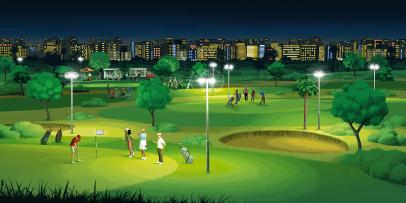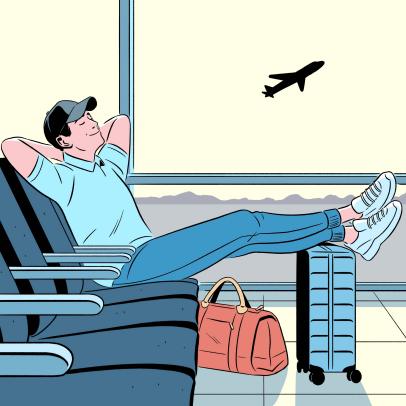lucky break
How a sunglasses startup created golf shades that don’t skimp on style

Illustration by Van Saiyan
The first entry in the entrepreneur’s handbook would probably say to find a popular, painful problem to solve. That’s how simple it was for Stephen Lease, who grew up around golf. His father was a greenskeeper at a Colorado public course. About 10 years ago, as a newly addicted distance runner, Lease was looking for affordable, stylish sunglasses that wouldn’t bounce or slide off his nose when he was putting in miles.
Finding nothing that ticked all those boxes, he and co-founders Ben Abell and Keri Blunt bootstrapped goodr, an affordable eyewear company, in 2015. “I had gotten really good at starting companies cheaply, figuring out if they were going to work quickly and shutting them down if they didn’t,” says Lease, who also worked in marketing for sports-equipment maker Easton-Bell and was a part of five failed active brand startups. “goodr was the result of some strong key learnings from those other mistakes.”

Instead of jumping into a startup with both feet, the founders kept their day jobs (Abell was a lawyer and Blunt an actress) and ran goodr as a side gig, selling their colorful glasses out of the trunks of their cars and keeping operating expenses as lean as possible by minimizing inventory. “We became known as the fun, active brand, and it was legit word of mouth, person to person,” Lease says. “I remember when an order came in from somebody in Illinois, and it was thrilling because I didn’t know anyone in Illinois. Then we started getting a few inquiries from running stores, and we slowly built from there.”
Where frames from high-end brands can cost upward of $250, goodrs land at three price points—$25, $35 and $45. They take advantage of designs, materials and manufacturing techniques that make them flexible and simple. “We don’t have any wire framing because that’s not durable or active,” Lease says about the line, which is made primarily of soft-touch coated plastic. “We think you should be able to wear the same sunglasses working out, playing golf and going to happy hour.”
goodr gained a foothold in the running and CrossFit communities and has gained traction in the golf market thanks to the sweat- and jounce-resistant designs—and because of a dumb-luck coincidence during product testing. “We intentionally make glasses for different sized faces, but at the beginning it was me testing them,” Lease says. “It turns out I have a face that’s exactly in the middle of the bell curve for size, so we unintentionally hit the sweet spot right out of the gate with frames that were pretty well sized for most people and weren’t tight or sliding around.”
What started as a business with founder-owners handing out glasses in plain black baggies at trail heads in California and Colorado was quickly growing, and goodr realized it needed better systems to handle that volume. “The first two years, we didn’t have a quality-control process,” Lease says. “It didn’t matter until 2017, when a batch of bad lenses got through, and it tanked our reviews, so I had to find someone to ask what to do about that. It wasn’t even something I knew I needed to know.”
Fast-forward to 2024, and goodr has expanded its frame offerings into pickleball, baseball, skiing and golf. Given Lease’s father worked at a course when Lease was growing up, the company’s golf line launched in 2023 proudly reflects that public-links heritage. The golf models have cheeky names like Back 9 Blackout, Clubhouse Closeout and Mind the Wage Gap Wedge, and they stand out in shades of yellow, green and orange.
The prices and flamboyant marketing are intentionally designed to liberate customers and let them explore their wild sides. “When we first started showing the glasses, people would put the black pairs on and put them back, and then put on an orange and blue pair, and they would get a huge smile,” Lease says. “For $25, we gave them permission to get the fun and wild thing they really want.”
Today, goodrs are sold in more than 5,000 stores worldwide and on the brand’s website. goodr offers 100 frame-and-color combinations, with 150 limited-release editions every year. “That first order was 1,800 frames,” Lease says. “Now, we buy them a container at a time—82,000 pairs. It seems like it has exploded, but if you look at the sales curve, using a golf analogy, we’re just at the range grinding on one shot and hitting the next one.”
Now if they could just make some sunglasses that stick upside down on the back of your hat.


